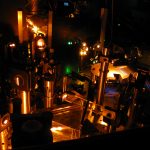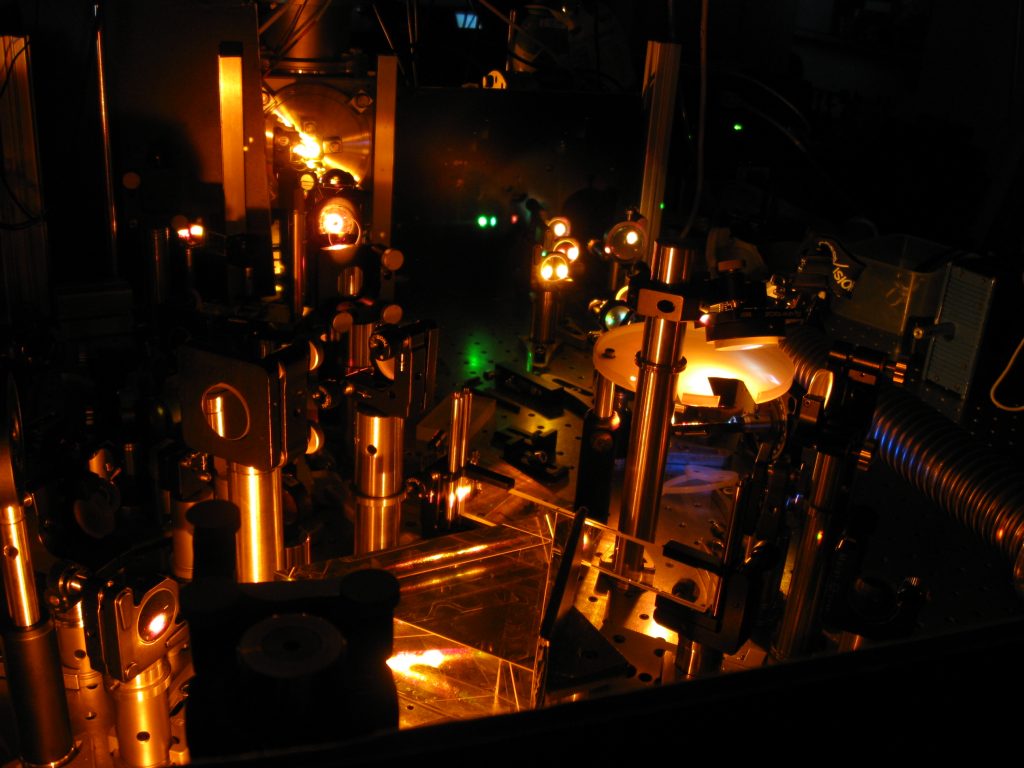
Regelungsstrategien für hoch-energetische gepulste Laserquellen
Projektschwerpunkte
- Mathematische Modellierung und Analyse auftretender Dynamiken im Laser
- Entwicklung modellbasierter adaptiver Pulsformungsalgorithmen
- Unterdrückung dynamischer Instabilitäten und stochastischer Fluktuationen durch Regelungsmethoden
- Ausloten des Potentials von integriertem Hardware/Software Codesigns für gepulste Laserquellen
Beschreibung
Kurze hochenergetische Laserpulse sind zu einem wertvollen und flexiblen Werkzeug mit Anwendungen von physikalischer und chemischer Grundlagenforschung (beispielsweise in der Hochenergiephysik, zum Pumpen optisch-parametrischer Verstärker und Freie-Elektronen-Laser, zur kohärenten Stimulation von atomarer und molekularer Prozesse) bis hin zur ablationsbasierten Materialbearbeitung und Augenchirurgie geworden. Die Erzeugung besonders kurzer Laserpulse geschieht dabei durch Injektion eines Quellpulses eines Oszillators (z.B. eines Mode-Locked-Lasers) in einen Resonator mit gepumptem Lasermedium – ein sogenanntes Master Oscillator Power Amplifier (MOPA) Konzept. Genügen auch etwas längere Pulsdauern, wird typischerweise gänzlich auf Quellpulse verzichtet und der Aufbau von optischer Energie im Resonator wird durch stochastische Zerfallsprozesse zufolge spontaner Emission selbsttätig angetrieben – wie in klassischen gütegeschalteten Lasern.
Viele zukunftsträchtige Anwendungsgebiete von gepulstem Laserlicht bedingen einen Betrieb der Laserquellen in zunehmend extremen und herausfordernden Betriebszuständen mit spezifischen Herausforderungen. Beispielsweise profitieren Oberflächenuntersuchungen und spektroskopische Anwendungen von hohen Pulswiederholraten, welche nahe oder innerhalb des instabilen Betriebsbereichs von gepumpten Resonatoren liegen. Dies ist besonders relevant wenn mehrstufige Verstärkerkaskaden auf Platz- und Kostengründen für die intendierte Anwendung nicht sinnvoll sind. Zusätzlich verhindern starke stochastische Energiefluktuationen zufolge spontaner Emission in gütegeschalteten Resonatoren den Einsatz in Messanwendungen. Die benötigten Bandbreiten für ultra-kurze Laserpulse deformieren den Laserpuls zudem stark, was zu zeitlich starken verbreiteten Ausgangspulsen führt.
Die notwendige Steuerungshardware in modernen Pulsquellen basiert weitgehend auf elektronisch programmierbaren optischen Aktuatoren wie beispielsweise akusto-optischen Modulatoren (AOMs) oder sog. spatial light modulators (SLMs). Dies legt die Verwendung regelungstechnischer Methoden nahe, um obige Effekte zu vermindern oder vollständig zu eliminieren. Insbesondere ermöglicht die systematische Einbeziehung von Regelungskonzepten während des optischen Laserdesigns die Entwicklung effizienterer, ökonomischerer und flexiblerer Lasersysteme.
Ausgewählte Publikationen
- A. Deutschmann-Olek, K. Schrom, and A. Kugi, Control of the formation and amplification of pulse bursts in regenerative amplifiers, IET Control Theory & Applications, vol. 17, iss. 4, p. 419–432, 2023.
[BibTex] [Download]@Article{DeutschmannOlek2023, author = {Deutschmann-Olek, Andreas and Schrom, Katharina and Kugi, Andreas}, title = {Control of the formation and amplification of pulse bursts in regenerative amplifiers}, doi = {10.1049/cth2.12378}, number = {4}, pages = {419--432}, volume = {17}, journal = {IET Control Theory \& Applications}, year = {2023}, } - L. Tarra, A. Deutschmann-Olek, and A. Kugi, Nonlinear feedback stabilisation and stochastic disturbance suppression of actively Q-switched lasers, in Proceedings of the 22nd IFAC World Congress, Yokohama, Japan, 2023 2023, pp. 77-82.
[BibTex]@InProceedings{Tarra2023, author = {Tarra, L. and Deutschmann-Olek, A. and Kugi, A.}, booktitle = {Proceedings of the 22nd IFAC World Congress}, date = {2023}, title = {Nonlinear feedback stabilisation and stochastic disturbance suppression of actively Q-switched lasers}, doi = {10.1016/j.ifacol.2023.10.1550}, number = {2}, pages = {77-82}, volume = {56}, address = {Yokohama, Japan}, issue = {2}, journaltitle = {IFAC-PapersOnLine}, month = {7}, year = {2023}, } - L. Tarra, A. Deutschmann-Olek, V. Stummer, T. Flöry, A. Baltuska, and A. Kugi, Stochastic nonlinear model of the dynamics of actively Q-switched lasers, Optics Express, vol. 30, iss. 18, p. 32411–32427, 2022.
[BibTex]@Article{Tarra2022, author = {Lukas Tarra and Andreas Deutschmann-Olek and Vinzenz Stummer and Tobias Fl\"{o}ry and Anrius Baltuska and Andreas Kugi}, title = {Stochastic nonlinear model of the dynamics of actively Q-switched lasers}, doi = {10.1364/OE.464508}, number = {18}, pages = {32411--32427}, url = {http://opg.optica.org/oe/abstract.cfm?URI=oe-30-18-32411}, volume = {30}, journal = {Optics Express}, keywords = {Amplified spontaneous emission; Fiber lasers; Q switched lasers; Random lasers; Spontaneous emission; Stimulated Brillouin scattering}, month = {Aug}, publisher = {Optica Publishing Group}, year = {2022}, } - A. Deutschmann, W. Kemmetmüller, and A. Kugi, On the global feedback stabilization of regenerative optical amplifiers, in Proceedings of the 21st IFAC World Congress, Berlin, Germany, 2020, p. 5447–5452.
[BibTex]@InProceedings{Deutschmann2020a, author = {A. Deutschmann and W. Kemmetmüller and A. Kugi}, booktitle = {Proceedings of the 21st IFAC World Congress}, title = {On the global feedback stabilization of regenerative optical amplifiers}, doi = {10.1016/j.ifacol.2020.12.1547}, note = {IFAC-PapersOnLine}, number = {2}, pages = {5447--5452}, volume = {53}, address = {Berlin, Germany}, issn = {2405-8963}, month = {06}, year = {2020}, } - A. Deutschmann, T. Flöry, K. Schrom, V. Stummer, A. Baltuška, and A. Kugi, Bifurcation suppression in regenerative amplifiers by active feedback methods, Optics Express, vol. 28, iss. 2, pp. 1722-1737, 2020.
[BibTex] [Download]@Article{Deutschmann2020, author = {Deutschmann, A. and Fl\"ory, T. and Schrom, K. and Stummer, V. and Baltu\v{s}ka, A. and Kugi, A.}, title = {Bifurcation suppression in regenerative amplifiers by active feedback methods}, journal = {Optics Express}, year = {2020}, volume = {28}, number = {2}, pages = {1722-1737}, doi = {10.1364/OE.380404}, } - A. Deutschmann, P. Malevich, A. Baltuska, and A. Kugi, Modeling and iterative pulse-shape control of optical chirped pulse amplifiers, Automatica, vol. 98, p. 150–158, 2018.
[BibTex] [Download]@Article{Deutschmann2018a, author = {Deutschmann, A. and Malevich, P. and Baltuska, A. and Kugi, A.}, title = {Modeling and iterative pulse-shape control of optical chirped pulse amplifiers}, journal = {Automatica}, year = {2018}, volume = {98}, pages = {150--158}, issn = {0005-1098}, doi = {10.1016/j.automatica.2018.09.002}, }
Partner
Ultrafast Laser Group, Institut für Photonik an der Technischen Universität Wien
Ansprechpartner
Dipl.-Ing. Dr.techn. BSc Andreas Deutschmann-OlekUniv.-Prof. Dr.techn. Andreas Kugi
ProjektmitarbeiterInnen
BSc MSc Lukas Kurt TarraDipl.-Ing. Dr.techn. BSc Andreas Deutschmann-Olek
